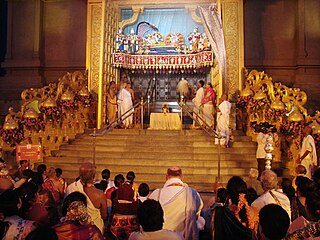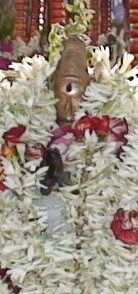
Alagar Koyil is a village in Madurai district in the South Indian state of Tamil Nadu. The history and living of the village is centered around Kallalagar Temple. Constructed in the Dravidian style of architecture, the temple is glorified in the Nalayira Divya Prabandham, the early medieval Tamil canon of the Alvar saints from the 6th–9th centuries CE. It is one of the 108 Divya Desams dedicated to Vishnu, who is worshiped as Kallalagar and his consort Lakshmi as Thirumamagal.

Melur is the Northern entrance of Madurai district. It is the town and municipality in the Madurai North in the Indian state of Tamil Nadu. Melur Old Name is Called Naduvi Nadu. The name Melur name comes from "Mela Nadu". Melur is called Thaigramam. It is the biggest taluk within the Madurai District. As of 2011, the town had a population of 40,017. Melur is an agricultural land in Madurai and the climate around the area is tropical.
Elumalai is a Panchayat town in the district of Madurai, in the Indian state of Tamil Nadu. Originally named Aezhumalai, the town is located near Usilampatti (18 km), Madurai (58 km), Theni (56 km), Peraiyur (24 km) and Tirumangalam (40 km) in the Western ghats.
Manamadurai is a Municipality Town in Sivaganga district in the Indian state of Tamil Nadu. Manamadurai falls under Manamadurai Legislative assembly.

Arulmigu Murugan Temple, Thiruparankundram is a Tamil temple dedicated to the god Murugan at Thiruparankundram, Tamilnadu, India. It is regarded as one of the "six Abodes of Murugan". The temple is built in rock-cut architecture and believed to have been built by the Pandyas during the 6th century. According to the legend. it is where Murugan slayed the demon Surapadman and married Devasena also known as Deivayanai, the daughter of the king of heavens, Indra. Also, Murugan is said to have worshipped his father Shiva here as Parangirinathar.

Arulmigu Meenakshi Sundaraswarar Temple is a historic Hindu temple located on the southern bank of the Vaigai River in the temple city of Madurai, Tamil Nadu, India. It is dedicated to the goddess Meenakshi, a form of Shakti, and her consort, Sundareshwarar, a form of Shiva. The temple is at the center of the ancient temple city of Madurai mentioned in the Tamil Sangam literature, with the goddess temple mentioned in 6th-century-CE texts. This temple is one of the Paadal Petra Sthalams, which are 275 temples of Shiva that are revered in the verses of Tamil Saiva Nayanars of 6th-9th century CE.

The Srivilliputhur Andal Temple in Srivilliputhur, a town in Virudhunagar district in the South Indian state of Tamil Nadu, is dedicated to the Hindu god Vishnu. It is located 80 km from Madurai. Constructed in the Dravidian style of architecture, the temple is glorified in the Nalayira Divya Prabandham, the early medieval Tamil canon of the Alvar saints from the 6th–9th centuries CE. It is one of the 108 Divya Desams dedicated to Vishnu, who is worshipped as Vatapatrasayi and his consort Lakshmi as Andal. It is believed to be the birthplace of two of the Alvars, namely Periyalvar and his foster-daughter, Andal.

Koodal Aḻagar Temple in Madurai, a city in the South Indian state of Tamil Nadu, is dedicated to the Hindu god Vishnu. Constructed in the Dravidian style of architecture, the temple is glorified in the Naalayira Divya Prabandham, the early medieval Tamil canon of the Alvar saints from the 6th–9th centuries CE. It is one of the 108 Divya Desams dedicated to Vishnu, who is worshipped as Viyooga Sundarrajan, and his consort Lakshmi as Mathuravalli.

Vaikuntha Ekadashi is a Hindu occasion and festival. It is primarily observed by Vaishnavas, who regard it to be a special Ekādaśī. It coincides with Mokṣadā Ekādaśī or Putrada Ekādaśī. It is observed on the 11th lunar day of the waxing lunar fortnight of the solar month of Dhanu. This falls between 16 December and 13 January in the Gregorian calendar.

Thiru Aappanoor is a smaller temple lying in the shadow of the Meenakshi Amman Temple in the holy city of Madurai, India. The Pandya Kings and the Royal Sethupathi kings made many contributions to this temple. It is one of the shrines of the 275 Paadal Petra Sthalams.

The Makara Nedunkuḻaikathar Temple is one of the Nava Tirupathi, nine Hindu temples dedicated to Vishnu located Thenthiruperai along Tiruchendur-Tirunelveli route, Tamil Nadu, India in the southern bank of Thamiraparani river. It is located 5 km from Alvar Thirunagari All these 9 temples are classified as Divya Desams, the 108 temples of Vishnu revered by the 12 poet saints, or Alvars. The temple is referred to as Sukra sthalam, a location for the planet deity, Sukra. Constructed in the Dravidian style of architecture, the temple is glorified in the Nalayira Divya Prabandham, the early medieval Tamil canon of the Alvar saints from the 6th–9th centuries CE. It is one of the 108 Divya Desams dedicated to Vishnu, who is worshipped as Makara Nedunkuḻaikathar and his consort Lakshmi as Tiruperai Nachiyar.

Vaithamanidhi Permual Temple is one of the nine Nava Tirupathi, the Hindu temples dedicated to Vishnu. It is located on the Tiruchendur–Tirunelveli route in Tamil Nadu, India, on the southern bank of the Thamiraparani River, 4 km from Alwarthirunagari. It is the eighth temple of Nava Tirupathi, and is named after Mars (Sevvai) and also called Kuberasthalam. Constructed in the Dravidian style of architecture, the temple is glorified in the Nalayira Divya Prabandham, the early medieval Tamil canon of the Alvar saints from the 6th–9th centuries CE. It is one of the 108 Divya Desams dedicated to Vishnu, who is worshipped as Vaithamanidhi Perumal and his consort Lakshmi as Kolurvalli.
Hinduism in Tamil Nadu finds its earliest literary mention in the Sangam literature dated to the 5th century BCE. The total number of Tamil Hindus as per 2011 Indian census is 63,188,168 which forms 87.58% of the total population of Tamil Nadu. Hinduism is the largest religion in Tamil Nadu.

Murthi Nayanar, also spelt as Murthy Nayanar, Moorthy Nayanar and Murti Nayanar and also known as Murtti, is a Nayanar saint, venerated in the Hindu sect of Shaivism. He is generally counted as the fifteenth in the list of 63 Nayanars.

Madavar Vilagam Vaidyanathar temple is a Shiva temple located in Madavar Vilagam, located in one kilometer southerly to Srivilliputhur in Virudhunagar district in the South Indian state of Tamil Nadu, is dedicated to the Hindu god Shiva. Constructed in the Dravidian style of architecture, the temple has two precincts. Shiva is worshiped as Vaidyanathar and his consort Parvati as Sivakami. The temple is the largest Shiva temple in the district. Shiva is worshipped as Vaidyanathar or the "God of healing". The holy water of the Siddhamirtham tank in the temple complex is believed to have curative effects, and a holy dip here is believed to cure all diseases. The temple was built by Thirumalai Nayak during the 16th century.

Kailasanathar Temple in Srivaikuntam, a village in Thoothukudi district in the South Indian state of Tamil Nadu, is dedicated to the Hindu god Shiva. It is located 30 km from Tirunelveli. Constructed in the Dravidian style of architecture, the temple has three precincts. Shiva is worshipped as Kailasanathar and his consort Parvati as Sivakami. The temple is the sixth temple in the series of Nava Kailasams where the presiding deity of all the nine temples is Kailasanathar and associated with a planetary deity. The temple is associated with the planet Saturn.

KallalagarTemple is a Hindu temple dedicated to Vishnu in Alagar Koyil, a village in Madurai district in the South Indian state of Tamil Nadu. Constructed in the Dravidian style of architecture, the temple is glorified in the Naalayira Divya Prabandham, the early medieval Tamil canon of the Alvar saints from the 6th–9th centuries CE. It is one of the 108 Divya Desams dedicated to Vishnu, who is worshiped as Kallalagar, and his consort Lakshmi as Thirumagal. This temple is called as Thirumaliruncholai in Sangam literatures and Naalayira Divya Prabandham sung by Tamil Alvar saints.

Kasi Viswanathar Temple in Tenkasi, a city in Tenkasi district in the South Indian state of Tamil Nadu, is dedicated to the Hindu god Shiva. Constructed in the Tamil style of architecture, the temple is believed to have been built by Pandyan ruler Parakrama Pandyan during the 13th century, with later additions from Madurai Nayaks. Shiva is worshipped as Kasi Viswanathar and his consort Parvathi as Ulagamman.
The Thiruvilaiyadal Puranam is a collection of sixty-four 7th-century Shaivite devotional epic stories by the sage Paranjothi. They describe the actions of Shiva on earth in a number of disguises to test and help his devotees.
Tallakulam or Thallaakulam is located in Madurai district, in the State of Tamil Nadu in India. There is a 'rest mandapam' called 'Ramanathapuram Sethupathi Mandapam' at Tallakulam. During Chithirai festival in the months of April - May, Lord Kallazhagar from Alagar temple visits so many mandapams in and around Madurai on his way to and fro Madurai. This year (2022) also, Lord Kallazhagar began his return journey to Alagarkoil from Ramanathapuram Sethupathi Mandapam at Tallakulam, mounted on 'Poo Pallakku' here at Tallakulam. Most Maduraiites go to have fun at the Tamukkam ground and explore the annual Government Chithirai Exhibition. As many as 90,361 people visited the 212th annual Government Chithirai Exhibition at Tamukkam ground.
















